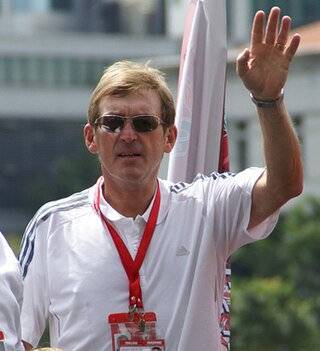
Sir Kenneth Mathieson Dalglish is a Scottish former football player and manager. During his career, he made 338 appearances for Celtic and 515 for Liverpool, playing as a forward, and earned a record 102 caps for the Scotland national team, scoring 30 goals, also a joint record. Dalglish won the Ballon d'Or Silver Award in 1983, the PFA Players' Player of the Year in 1983, and the FWA Footballer of the Year in 1979 and 1983. In 2009, FourFourTwo magazine named Dalglish the greatest striker in post-war British football, and he has been inducted into both the Scottish and English Football Halls of Fame. He is very highly regarded by Liverpool fans, who still affectionately refer to him as King Kenny, and in 2006 voted him top of the fans' poll "100 Players Who Shook the Kop".

Hampden Park, often referred to as Hampden, is a football stadium in the Mount Florida area of Glasgow, Scotland. The 51,866-capacity venue serves as the national stadium of football in Scotland. It is the normal home venue of the Scotland national football team and was the home of club side Queen's Park for over a century. Hampden regularly hosts the latter stages of the Scottish Cup and Scottish League Cup competitions and has also been used for music concerts and other sporting events, such as when it was reconfigured as an athletics stadium for the 2014 Commonwealth Games.

Third Lanark Athletic Club was a Scottish football club based in Glasgow. Founded in 1872 as an offshoot of the 3rd Lanarkshire Rifle Volunteers, the club was a founder member of the Scottish Football Association (SFA) in 1872 and the Scottish Football League (SFL) in 1890. Third Lanark played in the top division of the SFL for the majority of the club's existence, and won the league championship in 1903–04. The club also won the Scottish Cup twice, in 1889 and 1905. Third Lanark went out of business in 1967, as a result of mismanagement, six years after having finished in third place in the SFL. Third Lanark's former ground, Cathkin Park in Crosshill, is still partially standing and is used for minor league football.
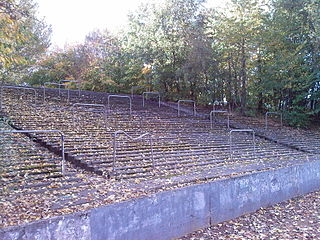
Cathkin Park is a municipal park in Glasgow, Scotland. The park is maintained by the city's parks department, and it is a public place where football is still played. The park contains the site of the second Hampden Park, previously home to the football clubs Queen's Park and Third Lanark. The site of the original Hampden Park is just to the west.

Toryglen is a district in southern Glasgow, Scotland, falling within the Langside ward under Glasgow City Council. It is approximately two miles south of the city centre, bounded to the west by Mount Florida, the north-west by Polmadie, to the north-east by the West Coast Main Line railway and the M74 motorway the south by King's Park, and immediately to the east by the town of Rutherglen.
Mount Florida is an area in the south-east of the city of Glasgow, Scotland.

Oatlands is an area in the city of Glasgow, Scotland. It is situated south of the River Clyde, falls within the Southside Central ward under Glasgow City Council, and is part of the Gorbals historic area. Its boundaries are Hutchesontown and the Southern Necropolis cemetery to the west, Polmadie to the south, Shawfield to the east, and Glasgow Green public park to the north.
Sport plays an important role in the culture of Glasgow, the largest city in Scotland. Association football is particularly popular: Glasgow is known for the fierce Old Firm rivalry between Scotland's most successful clubs, Celtic and Rangers. The national stadium, Hampden Park, is located in the city and stages most home matches of the Scotland national team, as well as the finals of the Scottish Cup and Scottish League Cup. The Scottish Football Association (SFA) and Scottish Professional Football League (SPFL) are both also based at Hampden. The world's first official international match took place in Glasgow in 1872.

New Douglas Park, currently known as the ZLX Stadium for sponsorship purposes, is a football stadium in Hamilton, South Lanarkshire, Scotland, which serves as the home of Scottish Championship side Hamilton Academical and Scottish League One side Clyde. It takes its name from Douglas Park, the club's former stadium which was located immediately to the south of the current site.

Lesser Hampden is a football stadium in Mount Florida, Glasgow, Scotland, which is located immediately beside the western end of Hampden Park stadium.

Hampden Park in Glasgow is the primary home stadium for the Scotland national football team. This has been the case since 1906, soon after it opened. The present site of Hampden Park is the third location to bear that name and both the previous locations also hosted Scotland games. Scotland have also played many of their home games in other stadiums throughout their history, both in friendly matches and for competitive tournaments.
The 1925–26 Scottish Cup was the 48th staging of Scotland's most prestigious football knockout competition. The tournament began on 23 January 1926 and ended on 10 April 1926. The cup was won by St Mirren, who defeated the previous years cup winners Celtic 2–0 in the final.
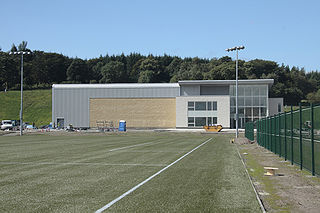
Lennoxtown Training Centre is Celtic F.C.'s training centre, located at Lennoxtown, East Dunbartonshire in Scotland. The complex houses the club's training and educational facilities.
Aberdeen University Sports Union (AUSU) is the sports union at the University of Aberdeen, Scotland. It is a constituent part of Aberdeen University Students' Association. It is not responsible for facilities and rents time for its clubs from Aberdeen Sports Village.

The 1874–75 Scottish Cup – officially the Scottish Football Association Challenge Cup – was the second season of Scotland's most prestigious football knockout competition. Teams from Edinburgh, Renfrewshire and Lanarkshire entered the competition for the first time and with 12 new teams entering the competition, a total of 25 were included in the first round draw. The competition began with the first round match between Rangers and Oxford on 10 October 1874 and concluded with the final on 10 April 1875. After 27 matches and 56 goals scored, defending champions Queen's Park retained the trophy by defeating Dunbartonshire club Renton 3–0 at the original Hampden Park.
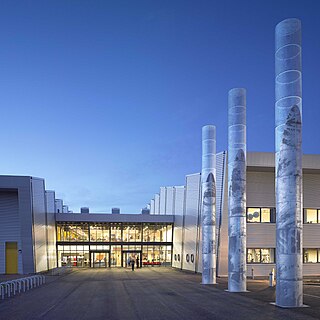
The Ravenscraig Regional Sports Facility is a public leisure centre that is located in the Ravenscraig area of Motherwell, North Lanarkshire, Scotland.
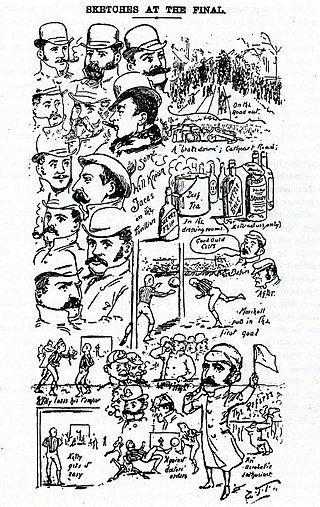
The 1889 Scottish Cup Final, colloquially known as the Snow final, was a football match played on 2 February 1889 at Hampden Park in Crosshill and was the final of the 16th staging of the Scottish Cup. Celtic and Third Lanark contested the match.
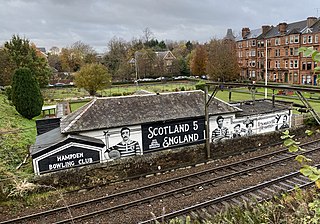
Hampden Park was a football ground in Glasgow, Scotland. The home ground of Queen's Park from 1873 until 1883, it was the first of three stadiums to bear the same name, and hosted the first-ever Scottish Cup final in 1874.
Oriam is Scotland's national performance centre for sport, based at Heriot-Watt University's Riccarton campus in Edinburgh. The Scottish Rugby Union and the Scottish Football Association use it as a training facility, Heart of Midlothian F.C. rent the centre for first-team training and to run their academy. It is also used by other sports teams, students and members of the public.
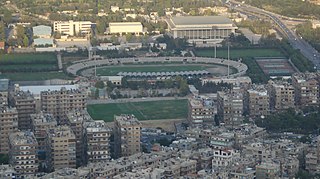
Al-Fayhaa Sports Complex, is a football training facility opened in 1976, serving as the headquarters of the Syrian Arab Federation for Football as well as the official training centre of the Syrian football team. It is located in the municipal district of al-Salihiyah at the heart of Damascus, the capital of Syria.

















